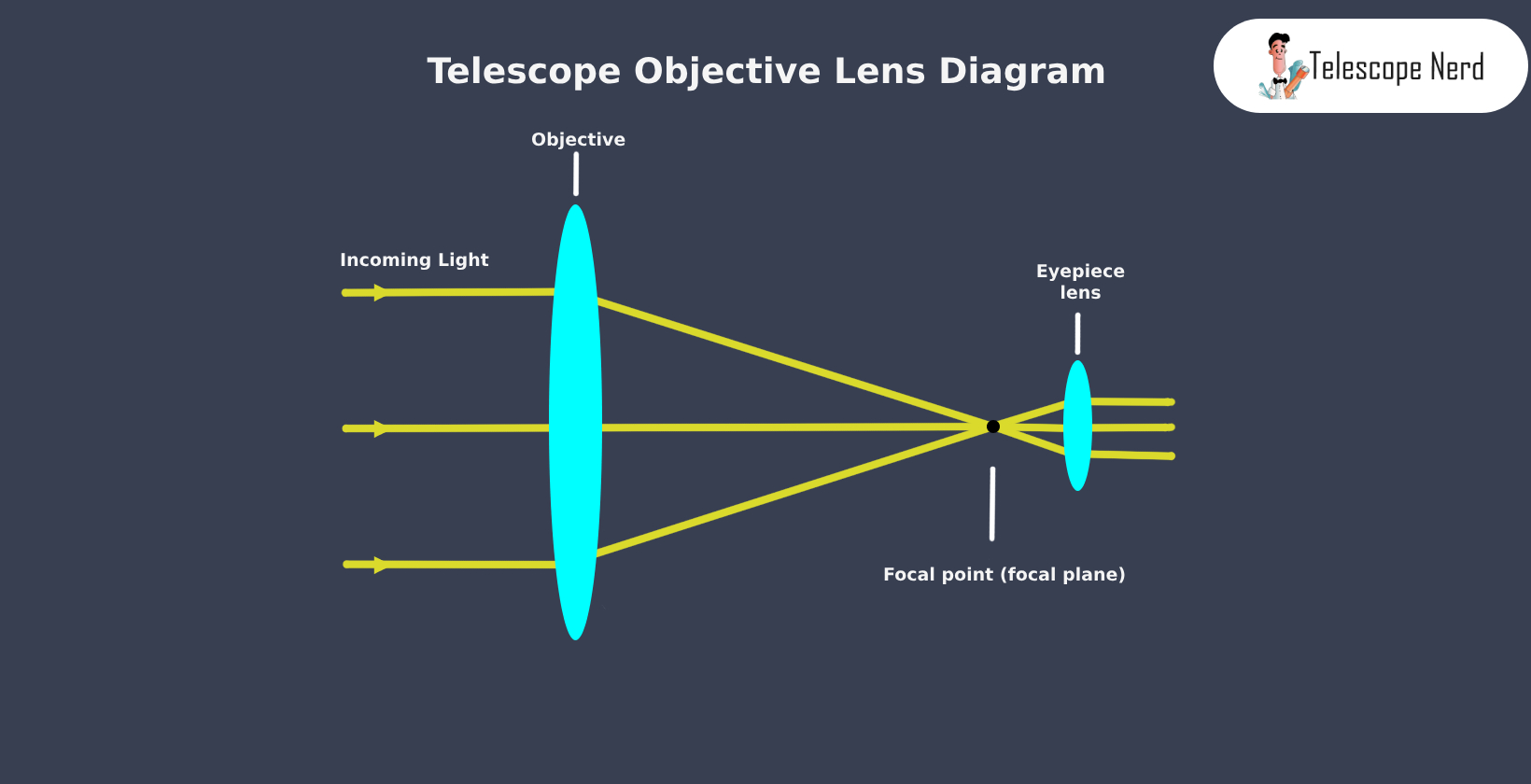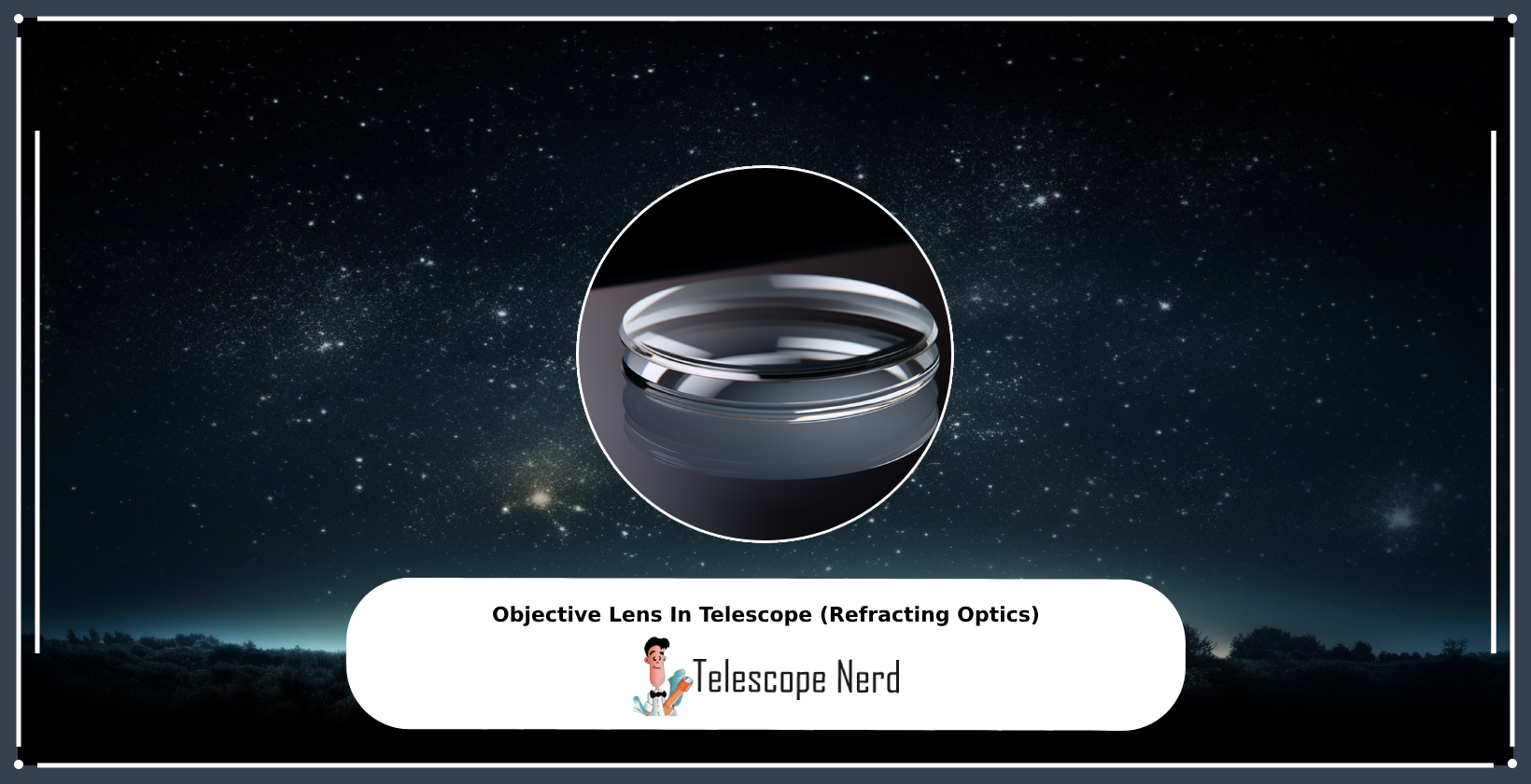Objective Lens In Telescope (Refracting Optics)
The objective lens is a part of a refracting telescope that collects and focuses light from distant objects. Knowing the design and material of an objective lens is crucial as it influences the telescope’s field of view, magnification, and overall performance.
The shape of the objective lens is convex, meaning it bulges outward. This design allows it to act as a converging lens, focusing parallel rays of light to converge at a focal point. The distance from the focal point to the objective lens is called the focal length.
The objective lens refracts light into the focal point because the lens is thinner at the edges than in the middle. When light passes through the thinner parts, it is refracted at a higher angle than in the middle. This causes light to converge into focus at the same point where it is magnified and observed.
Some telescopes incorporate multiple lenses in their design, with each lens serving to correct aberrations or enhance the image quality. The choice and combination of lenses influences various factors, including the telescope’s focal length, magnification, and overall performance.
The objective lens of a telescope, integral to the viewing experience, is constructed using a combination of materials. The lens is typically crafted from crown or flint glass, each known for its unique refractive properties. The objective lens is secured within the telescope’s optical tube assembly (OTA). To enhance performance, the surface of the objective lens should be treated with anti-reflective coatings, commonly derived from materials such as magnesium fluoride, to maximize light transmission and minimize unwanted reflections. Each material, combined with its quality and any applied coatings, plays a pivotal role in determining the clarity, brightness, and color accuracy of the images produced by the telescope.
How Does Objective Lens Affect Telescope Performance?

The objective lens directly affects telescope’s performance, including the magnification, light-gathering power and resolution. The curvature of this lens plays a pivotal role in determining the telescope’s focal length. A stronger curvature bends light at a higher angle, causing it to focus at a shorter distance. This results in a shorter focal length because focal length describes the distance from the objective lens to the focal point.
A smaller curvature will cause light to focus further from the objective, increasing the focal length. The increase in focal length will provide more detailed images of distant objects, but it also narrows the field of view. Decreasing the curvature, thus increasing the focal length, will also result in higher magnification.
The objective lens also affects the brightness and clarity of the image. A lens with a larger diameter collects more light, resulting in brighter and more detailed images. The quality of the lens material and its coatings also influences the clarity and color accuracy by reducing aberrations.
In refractors, the objective lens is designed to focus different wavelengths of light onto the same plane. While this design leads to chromatic aberrations, where colors don’t converge at the same point, the lens’s precise curvature effectively reduces coma.
Although these aberrations negatively impact the telescope’s performance, proper maintenance of the objective lens can mitigate their effects. Dust, smudges, or scratches will degrade the image quality. Regular maintenance along with careful handling will prolong the lens’s life and maintain its performance.
What Maintenance Does Objective Lens Require?
Maintenance of objective lens requires protecting it from scratches, cleaning from dust and storing in dry environment.
To prolong the life of an objective lens, it’s crucial to maintain it properly by protecting it from scratches and pollutants, like dust. Dust accumulation not only compromises image clarity but also leads to optical aberrations if not addressed.
To maintain the condition of the lens, use a lens cap consistently when the telescope is not in active use. To clean an objective lens, begin with a soft brush or compressed air to delicately remove any loose dust particles. If the lens has more stubborn marks or smudges, use a lens cleaning solution with a microfiber cloth. It’s crucial to remember to apply the solution to the cloth and not directly onto the lens, using gentle, circular motions to avoid potential damage. Excessive or incorrect cleaning methods will inadvertently scratch the lens or harm its protective coating.
It’s also important to monitor other components such as the lens mount, where the objective lens is attached to the telescope. The lens mount should be periodically inspected for debris to ensure the telescope focuses optimally. Additionally, the storage environment of the telescope plays a pivotal role in its longevity. A dry environment is paramount to prevent the onset of fungus or moisture damage to the objective lens.
The maintenance of an objective lens in a refractor is easier than a primary mirror in a reflector, due to the delicate nature of mirrors. However, both types of telescopes provide both upsides and downsides.
What are the Downsides of Optics That Use Lens as an Objective?
The downsides of using an objective lens are primarily chromatic aberration, weight and size constraints, and potential lens imperfections.
Chromatic aberration occurs because objective lenses refract different wavelengths of light at varying angles. This results in a failure to focus all colors to the same convergence point, leading to color fringing around observed objects.
Weight and size constraints arise because crafting large, high-quality lenses is both challenging and heavy, limiting the practical size of refracting telescopes. The process involves shaping and polishing thick glass or other transparent materials to exact specifications, ensuring that the entire lens is free from imperfections. As the diameter of the lens increases, the challenges in manufacturing become exponentially more complex.
In refracting telescopes, the entire volume of objective lenses must be free from imperfections, as any flaws will lead to image distortion. This is because light must pass through the entire lens uninterrupted, while in reflecting telescopes, only the surface quality is critical for accurate image representation.
Which Type of Telescope Uses Lens as an Objective?
Refracting telescopes use an objective lens as their primary optical component. A refracting telescope, or refractor, operates on the principle of refraction, using an objective lens to gather and bend incoming light. At the front of a reflector, this lens refracts and concentrates the light rays to a focal point inside the telescope.

